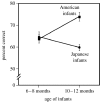Phonetic learning as a pathway to language: new data and native language magnet theory expanded (NLM-e)
- PMID: 17846016
- PMCID: PMC2606791
- DOI: 10.1098/rstb.2007.2154
Phonetic learning as a pathway to language: new data and native language magnet theory expanded (NLM-e)
Abstract
Infants' speech perception skills show a dual change towards the end of the first year of life. Not only does non-native speech perception decline, as often shown, but native language speech perception skills show improvement, reflecting a facilitative effect of experience with native language. The mechanism underlying change at this point in development, and the relationship between the change in native and non-native speech perception, is of theoretical interest. As shown in new data presented here, at the cusp of this developmental change, infants' native and non-native phonetic perception skills predict later language ability, but in opposite directions. Better native language skill at 7.5 months of age predicts faster language advancement, whereas better non-native language skill predicts slower advancement. We suggest that native language phonetic performance is indicative of neural commitment to the native language, while non-native phonetic performance reveals uncommitted neural circuitry. This paper has three goals: (i) to review existing models of phonetic perception development, (ii) to present new event-related potential data showing that native and non-native phonetic perception at 7.5 months of age predicts language growth over the next 2 years, and (iii) to describe a revised version of our previous model, the native language magnet model, expanded (NLM-e). NLM-e incorporates five new principles. Specific testable predictions for future research programmes are described.
Figures





References
-
- Baldwin D.A. Understanding the link between joint attention and language. In: Moore C, Dunham P.J, editors. Joint attention: its origins and role in development. Lawrence Erlbaum Associates; Hillsdale, NJ: 1995. pp. 131–158.
-
- Baldwin D.A, Markman E.M. Establishing word-object relations: a first step. Child Dev. 1989;60:381–398. - PubMed
-
- Ballem K.D, Plunkett K. Phonological specificity in children at 1; 2. J. Child Lang. 2005;32:159–173. doi:10.1017/S0305000904006567 - DOI - PubMed
-
- Baptista L.F, Petrinovich L. Song development in the white-crowned sparrow: social factors and sex differences. Anim. Behav. 1986;34:1359–1371. doi:10.1016/S0003-3472(86)80207-X - DOI
-
- Baran J.A, Laufer M.Z, Daniloff R. Phonological contrastivity in conversation: a comparative study of voice onset time. J. Phonet. 1977;5:339–350.
Publication types
MeSH terms
Grants and funding
LinkOut - more resources
Full Text Sources
Other Literature Sources
Medical
Research Materials

